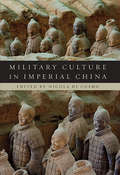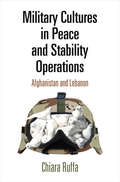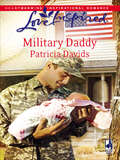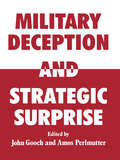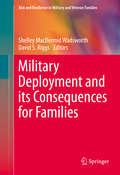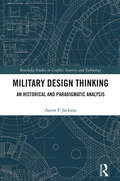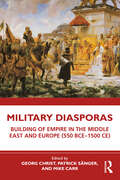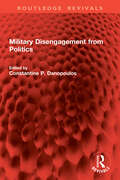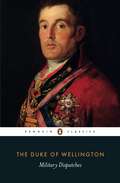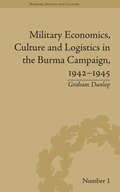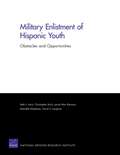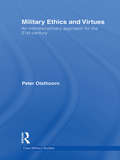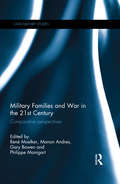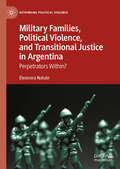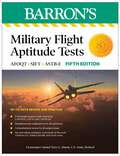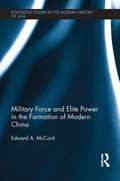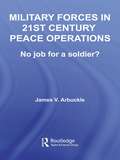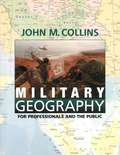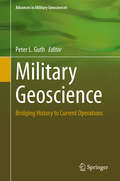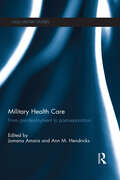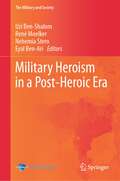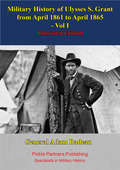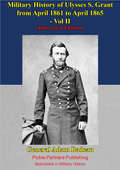- Table View
- List View
Military Culture in Imperial China
by Nicola Di CosmoThis volume explores the relationship between culture and the military in Chinese society from early China to the Qing empire, with contributions by eminent scholars aiming to reexamine the relationship between military matters and law, government, historiography, art, philosophy, literature, and politics. The book critically investigates the perception that, due to the influence of Confucianism, Chinese culture has systematically devalued military matters. There was nothing inherently pacifist about the Chinese governments’ views of war, and pragmatic approaches—even aggressive and expansionist projects—often prevailed. Though it has changed in form, a military elite has existed in China from the beginning of its history, and military service included a large proportion of the population at any given time. Popular literature praised the martial ethos of fighting men. Civil officials attended constantly to military matters on the administrative and financial ends. The seven military classics produced in antiquity continued to be read even into the modern period. These original essays explore the ways in which intellectual, civilian, and literary elements helped shape the nature of military institutions, theory, and the culture of war. This important contribution bridges two literatures, military and cultural, that seldom appear together in the study of China, and deepens our understanding of war and society in Chinese history.
Military Cultures in Peace and Stability Operations: Afghanistan and Lebanon
by Chiara RuffaAs of September 2017, the United Nations alone deployed 110,000 uniformed personnel from 122 countries in fifteen peacekeeping operations worldwide. Soldiers in these missions are important actors who not only have considerable responsibility for implementing peace and stability operations but also have a concomitant influence on their goals and impact. Yet we know surprisingly little about the factors that prompt soldiers' behavior. Despite being deployed on the same mission under similar conditions, various national contingents display significant, systematic differences in their actions on the ground.In Military Cultures in Peace and Stability Operations, Chiara Ruffa challenges the widely held assumption that military contingents, regardless of their origins, implement mandates in a similar manner. She argues instead that military culture—the set of attitudes, values, and beliefs instilled into an army and transmitted across generations of those in uniform —influences how soldiers behave at the tactical level. When soldiers are abroad, they are usually deployed as units, and when a military unit deploys, its military culture goes with it. By investigating where military culture comes from, Ruffa demonstrates why military units conduct themselves the way they do.Between 2007 and 2014, Ruffa was embedded in French and Italian units deployed under comparable circumstances in two different kinds of peace and stability operations: the United Nations Interim Force in Lebanon and the NATO mission in Afghanistan. Based on hundreds of interviews, she finds that while French units prioritized patrolling and the display of high levels of protection and force—such as body armor and weaponry—Italian units placed greater emphasis on delivering humanitarian aid. She concludes that civil-military relations and societal beliefs about the use of force in the units' home country have an impact on the military culture overseas, soldiers' perceptions and behavior, and, ultimately, consequences for their ability to keep the peace.
Military Daddy
by Patricia DavidsA surprise pregnancy challenges the values of an army corporal and a recovering alcoholic in this dramatic inspirational romance.A brash military man like Corporal Shane Ross was not the kind of father Annie Delmar had ever imagined having for her children. But they’d made a mistake that led to an unexpected blessing: Annie was pregnant. Shane wanted to be part of his child’s life . . . and part of Annie’s. He said he wanted to give his unborn child the family he never had. Annie didn’t know what to make of it, but everyone deserved a second chance. And maybe a military man with strong values would make a great daddy after all. . . .
Military Deception and Strategic Surprise!
by John Gooch Amos PerlmutterPublished in 2004, Military Deception and Strategic Surprise! is a valuable contribution to the field of Military and Strategic Studies.
Military Deployment and its Consequences for Families
by Shelley Macdermid Wadsworth David S. RiggsWar-related separations challenge families in many ways. The worry and uncertainty associated with combat deployments provokes anxiety in family members left at home. Lengthy separations may challenge the personal, social, and economic coping resources of families at home. In this war, thanks to medical advances, many service members who previously would have died of their injuries are returning home to live long, although altered lives. As a result, families are facing the additional challenge of assisting service members who have experienced amputation, traumatic brain injury, and psychological wounds. These challenges are faced not only by service members in the active component of the armed forces, but also by service members in the National Guard and Reserves. In response, the Department of Defense has launched unprecedented efforts to support service members and families before, during and after deployment in all locations of the country as well as in remote locations. These support efforts are focused not only on medical care, but also mental health care and logistical support. Research about families and war tends to move forward in fits and starts associated with major conflicts, and there is currently an increasing flow of family research moving into the scientific domain. Military Families and the Aftermath of Deployment focuses heavily on the aftermath of deployment for families. It is the first compilation of such chapters released in relation to the wars in Iraq and Afghanistan, and includes contributions from leading researchers from diverse disciplines and arenas, including universities, the Veterans Administration, and the Department of Defense, as well as international researchers from Canada, and Croatia, among others. This work will be of use to graduate students and researchers in family studies, social work, counseling, military science, psychology and sociology.
Military Design Thinking: An Historical and Paradigmatic Analysis (Routledge Studies in Conflict, Security and Technology)
by Aaron P. JacksonThis book examines the newly emergent field of military design thinking, how it has been developed inside and outside of military doctrine, and the paradigms that underlie its key thinkers and methodologies.From the emergence of its initial methodologies in the late 1990s, military design thinking’s development rapidly accelerated in the mid-2000s in response to perceived failures of existing military doctrine and practice to adapt to the wars of the early 21st century. To establish a foundation for exploring the significance of the challenge military design thinking presented to dominant approaches to warfare, the early chapters in the book examine the ontology and epistemology of military doctrine, which is defined as a written expression of a military’s institutional belief system regarding how to wage war. They also explain how attempts to incorporate military design thinking into doctrine ultimately led to its assimilation into this belief system, requiring military design thinkers to continue to explore and develop the field outside of doctrine. Since the mid-2010s, non-doctrinal military design methodologies have become increasingly prominent within several Western militaries, including the US, Canada, UK, Australia, and several European militaries. Later chapters offer an exploration of the paradigms underlying non-doctrinal as well as doctrinal design methodologies. This book highlights how the field has evolved, shows how military design thinking differs from its ‘civilian’ equivalents developed in fields such as commerce and business management, and discusses how it may evolve in the near future.This book will be of much interest to students of military studies, security studies, and international relations, as well as to military professionals.
Military Diasporas: Building of Empire in the Middle East and Europe (550 BCE-1500 CE)
by Mike Carr Georg Christ Patrick SängerMilitary Diasporas proposes a new research approach to analyse the role of foreign military personnel as composite and partly imagined para-ethnic groups. These groups not only buttressed a state or empire’s military might but crucially connected, policed, and administered (parts of) realms as a transcultural and transimperial class while representing the polity’s universal or at least cosmopolitan aspirations at court or on diplomatic and military missions. Case studies of foreign militaries with a focus on their diasporic elements include the Achaemenid Empire, Ptolemaic Egypt, and the Roman Empire in the ancient world. These are followed by chapters on the Sassanid and Islamic occupation of Egypt, Byzantium, the Latin Aegean (Catalan Company) to Iberian Christian noblemen serving North African Islamic rulers, Mamluks and Italian Stradiots, followed by chapters on military diasporas in Hungary, the Teutonic Order including the Sword Brethren, and the Swiss military. The volume thus covers a broad band of military diasporic experiences and highlights aspects of their role in the building of state and empire from Antiquity to the late Middle Ages and from Persia via Egypt to the Baltic. With a broad chronological and geographic range, this volume is the ideal resource for upper-level undergraduates, postgraduates, and scholars interested in the history of war and warfare from Antiquity to the sixteenth century.
Military Disengagement from Politics (Routledge Revivals)
by Constantine P. DanopoulosFirst published in 1988, Military Disengagement from Politics explores the reasons and conditions for military withdrawal from politics. It gives an in-depth analysis of specific grounds and circumstances of a representative list of countries whose military intervened, ruled, and eventually withdrew allowing for either full-scale civilian rule, or a more circumscribed set up in which the armed forces retain varying degrees of control in the governing process.The book provides a comparative and cross-cultural examination of eight countries covering a wide region of the world. It offers a carefully chosen array of case studies representing Asia, Africa, Europe, the Middle East, and Central and South America. This volume is a must read for students and researchers of political science.
Military Dispatches
by The Duke WellingtonThe vivid and exciting accounts written from the front line, taking the story of the British war with Napoleon from its desperate beginnings in Portugal to the final triumph at WaterlooThe Duke of Wellington was not only an incomparable battle commander but a remarkably expressive, fluent and powerful writer. His dispatches have long been viewed as classics of military literature and have been pillaged by all writers on the Peninsular War and the final campaigns in France and Belgium ever since they were published. This new selection allows the reader to follow the extraordinary epic in Wellington's own words - from the tentative beginnings in 1808, clinging to a small area of Portugal in the face of overwhelming French power across the whole of the rest of Europe, to the campaigns that over six years devastated opponent after opponent. The book ends with Wellington's invasion of France and the coda of 'the 100 days' that ended with Napoleon's final defeat at Waterloo.
Military Dogs of World War II (Casemate Illustrated)
by Susan Bulanda"Military Dogs of World War II examines a heartwarming but serious topic and reminds senior leaders and servicemembers of all ranks of the critical contributions made by every level of the force. It is an illuminating quick read on an often overlooked and ongoing part of the overall military effort." – Parameters Animals, especially dogs, have served in all the wars of men since time immemorial. During World War II, most combatant nations employed dogs on the battlefield in a number of ways including searching for injured men or downed airmen; detecting mines; carrying messages between units or dragging communications wires, particularly in difficult terrain; transporting supplies; and sentry duty. This illustrated book is an overview of how dogs were trained and used in WWII by different countries, including the stories of some of the individual animals that served. It also summarizes the various programs established to take care of the animals and send them home after the war.
Military Economics, Culture and Logistics in the Burma Campaign, 1942-1945 (Warfare, Society and Culture #1)
by Graham DunlopFollowing the fall of Burma to the Japanese in May 1942, reopening and expanding the link from India to China through Burma became the allied force's principal war aim in South-East Asia. This book argues that the campaign's development was driven more by what was logistictically possible than by pure strategic intent.
Military Encounters with Extraterrestrials: The Real War of the Worlds
by Frank JosephThe first, comprehensive military history of armed confrontations between humans and extraterrestrials • Includes documentation of incidents from World War I, World War II, the Korean War, the Vietnam War, the Gulf War, and the ongoing hostilities in the Middle East • Reveals the U.S. Navy’s defeat in Antarctica by ETs, the shoot-down of “flying saucers” at Roswell, alien sabotage of nuclear weapons, in-flight abductions of USAF and Soviet officers, and photographic evidence of the Battle of Los Angeles • Explains the link between the development of atomic bombs and ballistic missiles and the increase in extraterrestrial intervention in the 20th century Although close encounters with alien space craft are reported as far back as the reign of Pharaoh Thutmosis III in Egypt, it wasn’t until the 20th century that UFO sightings and extraterrestrial encounters were truly documented, due to advances in technology and record-keeping as well as the vast increase in incidents, particularly with military forces. Revealing his extensive research and the verifiable evidence he’s discovered, Frank Joseph presents a comprehensive military history of armed confrontations between humans and extraterrestrials in the 20th and 21st centuries. He explains how, with the development of atomic bombs and ballistic missiles, the frequency of extraterrestrial intervention in human affairs increased dramatically. He documents incidents both famous and little known, including the explosive demolition of U.S. munitions factories in 1916 by unearthly aerial vehicles, the Red Baron’s dogfight with a UFO during World War I, “foo fighter” sightings and battles with Allied and Axis combatants during World War II, and eye-witness reports from encounters during the Korean War, the Vietnam War, the Gulf War in Iraq, and the ongoing hostilities in the Middle East. He examines the evidence for the shoot-down of “flying saucers” at Roswell and Aztec, New Mexico, alien sabotage of nuclear weapons systems, and in-flight abductions of USAF and Soviet officers and airplanes. He explores the photo evidence for the Battle of Los Angeles, which occurred three months after Pearl Harbor, and the details of Operation Highjump, the U.S. Navy’s defeat in Antarctica by ET forces 17 months after the atomic bomb was dropped on Nagasaki, while also uncovering evidence of secret Antarctic German bases. The author also examines recent, 21st-century examples of alien interdiction in Earthly affairs, such as the meltdown of the Fukushima Daiichi nuclear plant in Japan and the fiery abort of Elon Musk’s Falcon 9 missile launch, both events accompanied by UFOs. Offering complete disclosure of the multitude of ET events over the past century, Frank Joseph gives us the first true reference book in the field of alien military encounters.
Military Enlistment of Hispanic Youth: Obstacles and Opportunities
by Beth J. Asch Jacob Alex Klerman David S. Loughran Meredith Kleykamp Christopher BuckAlthough polls of Hispanic youth show a strong propensity to serve in the military, Hispanics are nonetheless underrepresented among military recruits. The authors discuss the major characteristics that disproportionately disqualify Hispanic youth and explore actions that could be taken to increase Hispanic enlistments.
Military Ethics and Virtues: An Interdisciplinary Approach for the 21st Century (Cass Military Studies)
by Peter OlsthoornThis book examines the role of military virtues in today's armed forces.Although long-established military virtues, such as honor, courage and loyalty, are what most armed forces today still use as guiding principles in an effort to enhance the moral behavior of soldiers, much depends on whether the military virtues adhered to by these militaries suit a particular mission or military operation. Clearly, the beneficiaries of these military virtues are the soldiers themselves, fellow-soldiers, and military organizations, yet there is little that regulates the behavior of soldiers towards civilian populations. As a result, troops trained for combat in today's missions sometimes experience difficulty in adjusting to the less aggressive ways of working needed to win the hearts and minds of local populations after major combat is over. It can be argued that today's missions call for virtues that are more inclusive than the traditional ones, which are mainly about enhancing military effectiveness, but a convincing case can be made that a lot can already be won by interpreting these traditional virtues in different ways. This volume offers an integrated approach to the main traditional virtues, exploring their possible relevance and proposing new ways of interpretation that are more in line with the military tasks of the 21st century.The book will be of much interest to students of military ethics, philosophy, and war and conflict in general.
Military Families and War in the 21st Century: Comparative perspectives (Cass Military Studies)
by Gary Bowen Philippe Manigart Rene Moelker Manon AndresThis book focuses on the key issues that affect military families when soldiers are deployed overseas, focusing on the support given to military personnel and families before, during and after missions. Today’s postmodern armies are expected to provide social-psychological support both to their personnel in military operations abroad and to their families at home. Since the end of the Cold War and even more so after 9/11, separations between military personnel and their families have become more frequent as there has been a multitude of missions carried out by multinational task forces all over the world. The book focuses on three central questions affecting military families. First, how do changing missions and tasks of the military affect soldiers and families? Second, what is the effect of deployments on the ones left behind? Third, what is the national structure of family support systems and its evolution? The book employs a multidisciplinary approach, with contributions from psychology, sociology, history, anthropology and others. In addition, it covers all the services, Army, Navy/Marines, Air Force, spanning a wide range of countries, including UK, USA, Belgium, Turkey, Australia and Japan. At the same time it takes a multitude of perspectives such as the theoretical, empirical, reflective, life events (narrative) approach, national and the global, and uses approaches from different disciplines and perspectives, combining them to produce a volume that enhances our knowledge and understanding of military families. This book will be of much interest to students of military studies, sociology, war and conflict studies and IR/political science in general.
Military Families, Political Violence, and Transitional Justice in Argentina: Perpetrators Within? (Rethinking Political Violence)
by Eleonora NatalePerpetrators within? provides the first ethnographic account of the experiences of military families of the Argentine dictatorship (1976-83). At the crossover of multiple disciplines, this groundbreaking study brings advancements in the fields of military and conflict studies, Latin American history, transitional justice and ethnographic methods. The military juntas that seized power in Argentina in 1976 waged a brutal 'dirty war' against communism, leading to seven years of authoritarian rule that claimed thousands of lives. The regime suppressed political opposition through kidnapping, torture, and clandestine executions. Although efforts to bring the military to justice began in 1985, legal obstacles delayed prosecutions for over 20 years. It wasn't until 2005 that trials resumed, resulting in the conviction of hundreds of former officers for crimes committed during the dictatorship. Perpetrators within? questions these unique subjects directly. For the first time, the military of the dictatorship are approached as a community of families and comrades (which includes spouses, children and ‘brothers in arms’) better to understand the personal and collective experiences of those linked to the regime's violent past. Based on extensive research with former junior officers –many now imprisoned – their wives and adult children, the book unveils the social and family life of the military of the 1970s, it investigates the everyday unexceptional scenarios of repression, and it describes the long road to justice from the point of view of military families involved in the trials. A vital contribution to understanding the workings of kinship, military power and violence, this book offers a deeper ad original perspective on one of the darkest chapters in Latin American history.
Military Flight Aptitude Tests, Fifth Edition: 6 Practice Tests + Comprehensive Review (Barron's Test Prep)
by Terry L. DuranBe prepared for exam day with Barron&’s. Trusted content from Military Flight Aptitude Test experts!Barron&’s Military Flight Aptitude Tests includes in-depth content review and practice. It&’s the only book you&’ll need to be prepared for exam day.Written by Experienced EducatorsLearn from Barron&’s--all content is written and reviewed by Military Flight Aptitude Test expertsBuild your understanding with comprehensive review tailored to the most recent exams:AFOQT (Air Force Officer Qualifying Test)SIFT (Army Selection Instrument for Flight Training)ASTB-E (Navy/Marine Corps/Coast Guard Aviation Selection Test Battery)Get a leg up with tips, strategies, and study advice for exam day--it&’s like having a trusted tutor by your sideBe Confident on Exam DaySharpen your test-taking skills with 6 practice tests, including 2 practice AFOQTs, 2 practice SIFTs, and 2 practice ASTB-EsReinforce your learning with detailed answers and explanations for all test questionsStrengthen your knowledge with in-depth review covering all major subtests and topics covered on each exam, including language, mathematics, technical knowledge, science, and mental skillsDeepen your understanding with expert advice about becoming an officer and aviator, detailed summaries of common aircraft used by the U.S. military today, a glossary of key terms and definitions, and much more
Military Force and Elite Power in the Formation of Modern China: Military Force And Elite Power In The Formation Of Modern China (Routledge Studies in the Modern History of Asia)
by Edward A. McCordThe China we know today emerged at the end of a long period of internal rebellions, civil wars, foreign invasions, and revolutionary insurrections that stretched across the nineteenth century to the mid-point of the twentieth. This book explores one important consequence of this situation—the increased role of military force in the determination of elite social, political, and economic power, and presents fascinating case studies of the warlords, militia leaders, and military officers who benefited from this. Examining the intersection of military force and elite power in the formative years of modern Chinese history, this book highlights just how important military force was to elite power in nineteenth- and early twentieth-century China in a context of frequent warfare and political turmoil. It shows that the way in which military empowerment unfolded and who exactly was empowered, depended heavily on shifting military and political conditions, and each case confirms the extent to which military force emerged as a consistently significant determinant of elite power across this period. Indeed, the transformative effect of military force on social and political structures of power revealed by these studies sheds distinctive light on the prevalence, and wide-ranging impact, of military conflicts in this period. In turn, these studies also provide a particular perspective on the fluid boundaries of, as well as the constraints on, elite power in Chinese society in a time of intense social and political change. This book makes an important contribution to our understanding of the rise of modern China, and provides a keen insight into impact of war on the country, as such, it will be welcomed by students and scholars interested in Chinese history, Asian history, and military history more broadly.
Military Forces in 21st Century Peace Operations: No Job for a Soldier? (Contemporary Security Studies)
by James V. ArbuckleA major new study of the realities of contemporary warfare, which presents a range of fresh insights and is essential reading for all students and professionals engaged in the field. This book clearly shows us that: neither military nor civilian agencies can act effectively alone in resolving modern conflicts joint civil-military efforts are needed, and those efforts must be deliberately planned from the outset of an operation; they cannot be added on as afterthoughts when all else has failed the record of our efforts over nearly a decade and a half since the end of the Cold War demonstrates that we are doing badly at creating civil-military partnerships, and that we are not getting better. James V. Arbuckle shows how these issues are neither structural nor organizational - they are cultural. They involve attitudes, beliefs, perceptions – positive and negative, true and false. The solutions will involve changing attitudes, moving beyond prejudices, replacing competition with cooperation. The principal mechanisms for this will be common civil-military training and education.
Military Geography: For Professionals and The Public
by John M. CollinsThis book covers many topics that are crucial to military planning but often receive only passing mention in histories or briefings. Collins, a former Army officer, stresses land geography, but he does not stint oceans, the atmosphere, or interplanetary space. His discussions of urban areas are too brief, given the increasing amount of large-scale violence in cities since the end of World War II.
Military Geoscience: Bridging History to Current Operations (Advances in Military Geosciences)
by Peter L. GuthThis book is a collection of papers presented at the 11th International Conference of Military Geoscience that was held in 2015. The conference included discussion on a diverse range of geosciences, including military history, military geology, teaching geology from a military prospective, geological influence on the battlefield, and environmental and cultural issues related to management of military lands. Geology and geography have played a significant role in military history, from providing the stone for primitive tools and weapons, to the utilization of terrain in offensive and defensive strategies. Specific to this volume, deserts comprise nearly a third of the Earth’s surface and have been the site of numerous battles where the dust, heat, and a lack of food and water have provided challenges to military leaders and warriors. This book examines the role of deserts in past and modern warfare, the problems and challenges in managing military lands in desert regions, and how desert environmental conditions can impact military equipment and personnel. This proceedings volume should be of interest to scholars, professionals, and those interested in military history, warfare, geology, geography, cultural resources, general science, and military operations.
Military Health Care: From Pre-Deployment to Post-Separation (Cass Military Studies)
by Jomana Amara Ann M. HendricksThis edited volume surveys critical aspects of modern military health care in the US and various other Western countries with troops in Iraq and Afghanistan. In the United States, the military medical system, including care for veterans, is large and diverse and involves two institutions, the US Department of Defense (DoD) and the US Department of Veteran’s Affairs (VA). Studying the system gives practitioners and policy-makers an understanding of the larger picture of the military medical structure, facilitating thought about some of the difficulties and opportunities for coordinating treatments and preparing for the future. This book covers health care issues prior to deployment, such as screening for mental health, evaluating long-term consequences of exposure to military service, and provision of insurance; care during a conflict, primarily battlefield clinics, battlefield trauma care, and evacuation procedures; and post- combat care, including serious war injuries, psychiatric, and long-term care. Bringing together research from a wide range of contributors, the volume provides readers with an extensive, up-to-date source of information on military medicine.This book will be of great interest to students of public health, military sociology, the Iraq war, US public policy, and war and conflict studies in general.
Military Heroism in a Post-Heroic Era (The Military and Society)
by Eyal Ben-Ari René Moelker Uzi Ben-Shalom Nehemia SternThis book explores the variety of forms that individual heroism and sacrifice can take in the context of contemporary military conflicts. It addresses three key questions: How has an enduring ideal of heroism been transformed by the nature of modern warfare? Are we now witnessing the emergence of new forms of exemplary military behavior? And, have new ideals of heroism (and by association, sacrifice or bravery) been added to older forms in the recent past? The book advocates viewing the concept of military heroism as a moral category, in which its theoretical definition and empirical practice reflect those factors that are seen as being vital for society itself. The key theoretical and topical challenges addressed in the respective chapters focus on how ideas of heroism become entwined with issues of individualization (bolstered by the cultural assumptions of neo-Liberalism), the spread of the human rights discourse, and the judicialization, marketization and mediatization of armedforces. The book was written by experts on military studies, including many who are currently active military personnel. It includes contributions from a variety of disciplines, e.g. anthropology, sociology, psychology, and political science.
Military History Of Ulysses S. Grant From April 1861 To April 1865 Vol. I (Military History Of Ulysses S. Grant From April 1861 To April 1865 #1)
by General Adam BadeauIncludes Civil War Map and Illustrations Pack - 224 battle plans, campaign maps and detailed analyses of actions spanning the entire period of hostilities.Few men can have known General and President of the United States Ulysses S. Grant as well as General Adam Badeau. As Grant's military secretary during 1864-1865, he came to know and work closely with the future president; he wrote his classic account of General Grant's military abilities. Allowed access to documents produced on both the Union and Confederate armies during the war, Badeau weaves these into an excellent narrative. As a soldier himself Badeau is able to give a critical account of the battles actions and motivations that Grant was engaged in.An excellent military biography.
Military History Of Ulysses S. Grant From April 1861 To April 1865 Vol. II (Military History Of Ulysses S. Grant From April 1861 To April 1865 #2)
by General Adam BadeauIncludes Civil War Map and Illustrations Pack - 224 battle plans, campaign maps and detailed analyses of actions spanning the entire period of hostilities.Few men can have known General and President of the United States Ulysses S. Grant as well as General Adam Badeau. As Grant's military secretary during 1864-1865, he came to know and work closely with the future president; he wrote his classic account of General Grant's military abilities. Allowed access to documents produced on both the Union and Confederate armies during the war, Badeau weaves these into an excellent narrative. As a soldier himself Badeau is able to give a critical account of the battles actions and motivations that Grant was engaged in.An excellent military biography.
